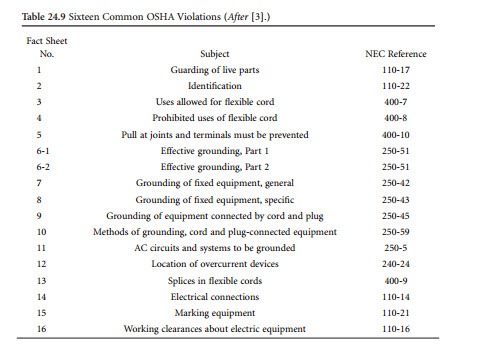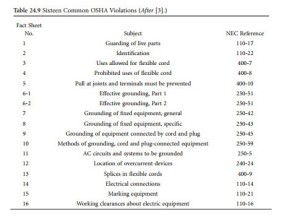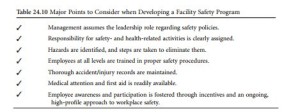OSHA Safety Requirements
The federal government has taken a number of steps to help improve safety within the workplace. OSHA, for example, helps industries to monitor and correct safety practices. The agency’s records show that electrical standards are among the most frequently violated of all safety standards. Table 24.9 lists 16 of the most common electrical violations, which include these areas:
• Protective covers
• Extension cords
• Grounding
Protective Covers
Exposure of live conductors is a common safety violation. All potentially dangerous electric conductors should be covered with protective panels. The danger is that someone can come into contact with the exposed, current-carrying conductors. It also is possible for metallic objects such as ladders, cable, or tools to contact a hazardous voltage, creating a life-threatening condition. Open panels also present a fire hazard.
Identification and Marking
Properly identify and label all circuit breakers and switch panels. The labels for breakers and equipment switches may be years old and may no longer describe the equipment that is actually in use. This confusion poses a safety hazard. Improper labeling of the circuit panel can lead to unnecessary damage — or worse, casualties — if the only person who understands the system is unavailable in an emergency. If there are a number of devices connected to a single disconnect switch or breaker, provide a diagram or drawing for clarification. Label with brief phrases, and use clear, permanent, and legible markings.
Equipment marking is a closely related area of concern. This is not the same thing as equipment identification. Marking equipment means labeling the equipment breaker panels and ac disconnect switches according to device rating. Breaker boxes should contain a nameplate showing the manufacturer name, rating, and other pertinent electrical factors. The intent of this rule is to prevent devices from being subjected to excessive loads or voltages.
Extension Cords
Extension (flexible) cords often are misused. Although it may be easy to connect a new piece of equip- ment with a flexible cord, be careful. The National Electrical Code lists only eight approved uses for flexi- ble cords.
The use of a flexible cord where the cable passes through a hole in the wall, ceiling, or floor is an often-violated rule. Running the cord through doorways, windows, or similar openings also is prohib- ited. A flexible cord should not be attached to building surfaces or concealed behind building walls or ceilings. These common violations are illustrated in Figure 24.9.
Along with improper use of flexible cords, failure to provide adequate strain relief on connectors is a common problem. Whenever possible, use manufactured cable connections.
Grounding
OSHA regulations describe two types of grounding: system grounding and equipment grounding. System grounding actually connects one of the current-carrying conductors (such as the terminals of a supply transformer) to ground. (See Figure 24.10.) Equipment grounding connects all the noncurrent-carrying metal surfaces together and to ground. From a grounding standpoint, the only difference between a grounded electrical system and an ungrounded electrical system is that the main-bonding jumper from the service equipment ground to a current-carrying conductor is omitted in the ungrounded system.
The system ground performs two tasks:
• It provides the final connection from equipment-grounding conductors to the grounded circuit conductor, thus completing the ground-fault loop.
• It solidly ties the electrical system and its enclosures to their surroundings (usually earth, structural steel, and plumbing). This prevents voltages at any source from rising to harmfully high voltage- to-ground levels.
It should be noted that equipment grounding — bonding all electric equipment to ground — is required whether or not the system is grounded. System grounding should be handled by the electrical contractor installing the power feeds.
Equipment grounding serves two important functions:
• It bonds all surfaces together so that there can be no voltage differences among them.
• It provides a ground-fault current path from a fault location back to the electrical source, so that if a fault current develops, it will operate the breaker, fuse, or GFCI.
The National Electrical Code is complex, and it contains numerous requirements concerning electri- cal safety. If the facility electric wiring system has gone through many changes over the years, have the entire system inspected by a qualified consultant. The fact sheets listed in Table 24.9 provide a good start- ing point for a self-evaluation. The fact sheets are available from any local OSHA office.
Management Responsibility
The key to operating a safe facility is diligent management. A carefully thought-out plan ensures a coor- dinated approach to protecting staff members from injury and the facility from potential litigation. Facil- ities that have effective accident-prevention programs follow seven basic guidelines. Although the details and overall organization may vary from workplace to workplace, these practices — summarized in Table — still apply.
If managers are concerned about safety, it is likely that employees also will be. Display safety pam- phlets, and recruit employee help in identifying hazards. Reward workers for good safety performance.
Employee awareness and participation is fostered through incentives and an ongoing, high-profile approach to workplace safety.
Often, an incentive program will help to encourage safe work practices. Eliminate any hazards identified, and obtain OSHA forms and any first aid supplies that would be needed in an emergency. The OSHA Handbook for Small Business outlines the legal requirements imposed by the Occupational Safety and Health Act of 1970. The handbook, which is available from OSHA, also suggests ways in which a com- pany can develop an effective safety program.
Free on-site consultations also are available from OSHA. A consultant will tour the facility and offer practical advice about safety. These consultants do not issue citations, propose penalties, or rou- tinely provide information about workplace conditions to the federal inspection staff. Contact the nearest OSHA office for additional information. Table 24.11 provides a basic checklist of safety points for consideration.
Maintaining safety standards is difficult in any size organization. A written safety manual that has specific practices and procedures for normal workplace hazards as well as the emergency-related hazards you identify is a good idea and may lower your insurance rates [4]. If outside workers set foot in your facility, prepare a special Safety Manual for Contractors. Include in it installation standards, compliance with Lock-Out/Tag-Out, and emergency contact names, and phone numbers. Lock-Out/Tag-Out is a set of standard safety policies that assure that energy is removed from equipment during installation and maintenance. It assures that every member of a work detail is clear before power is reapplied. Make sure out- side contractors carry proper insurance and are qualified, licensed, or certified to do the work for which you contract.




